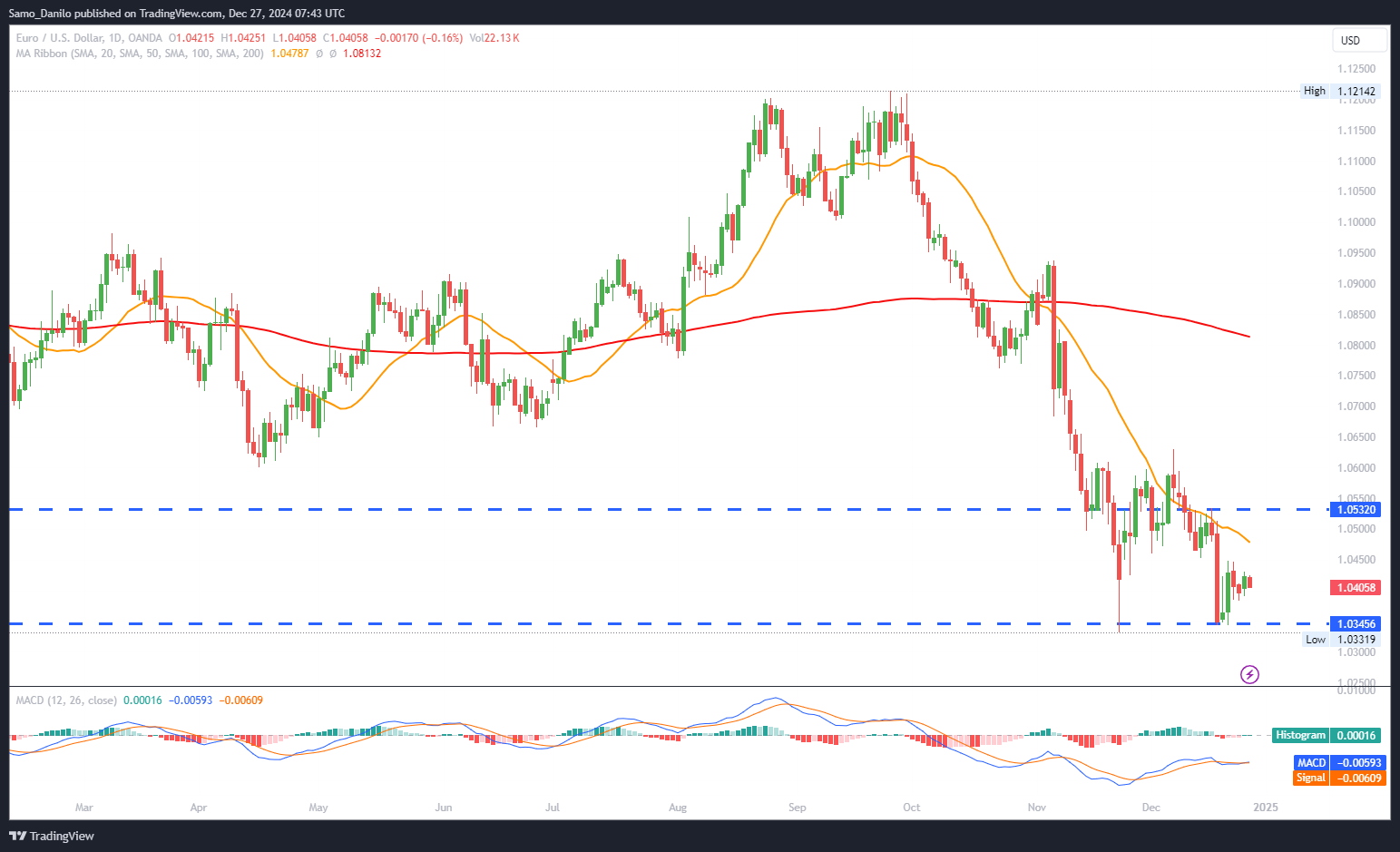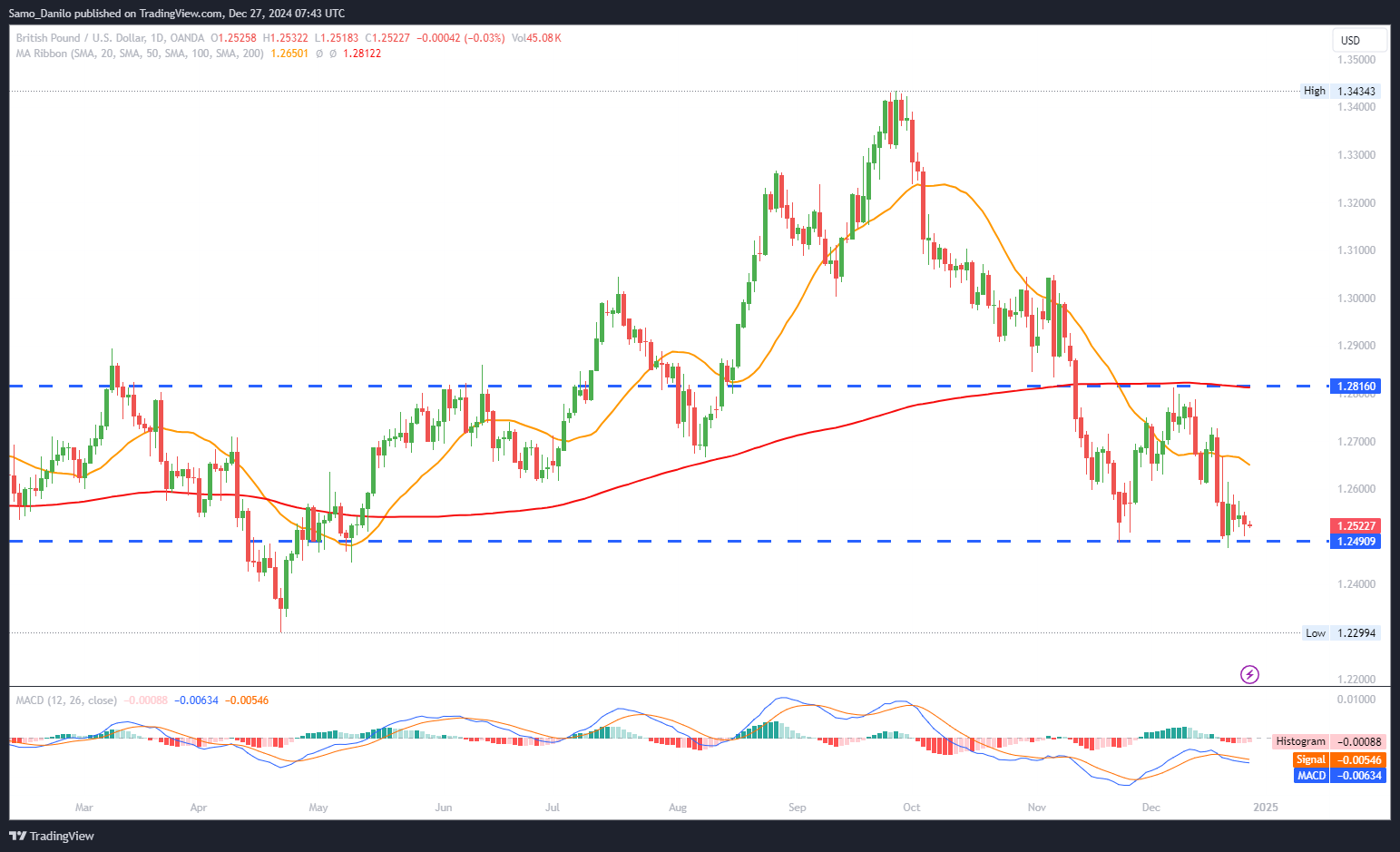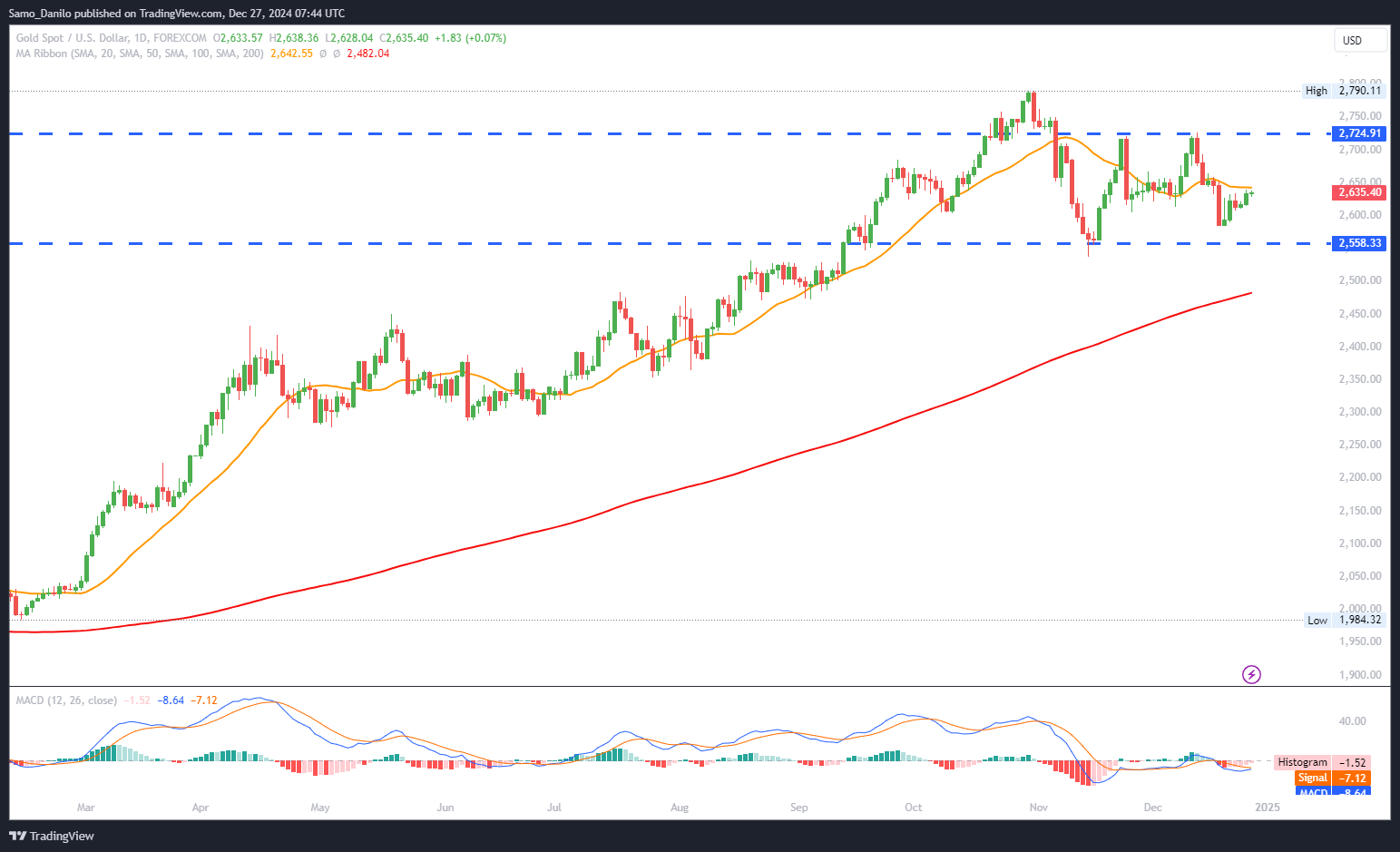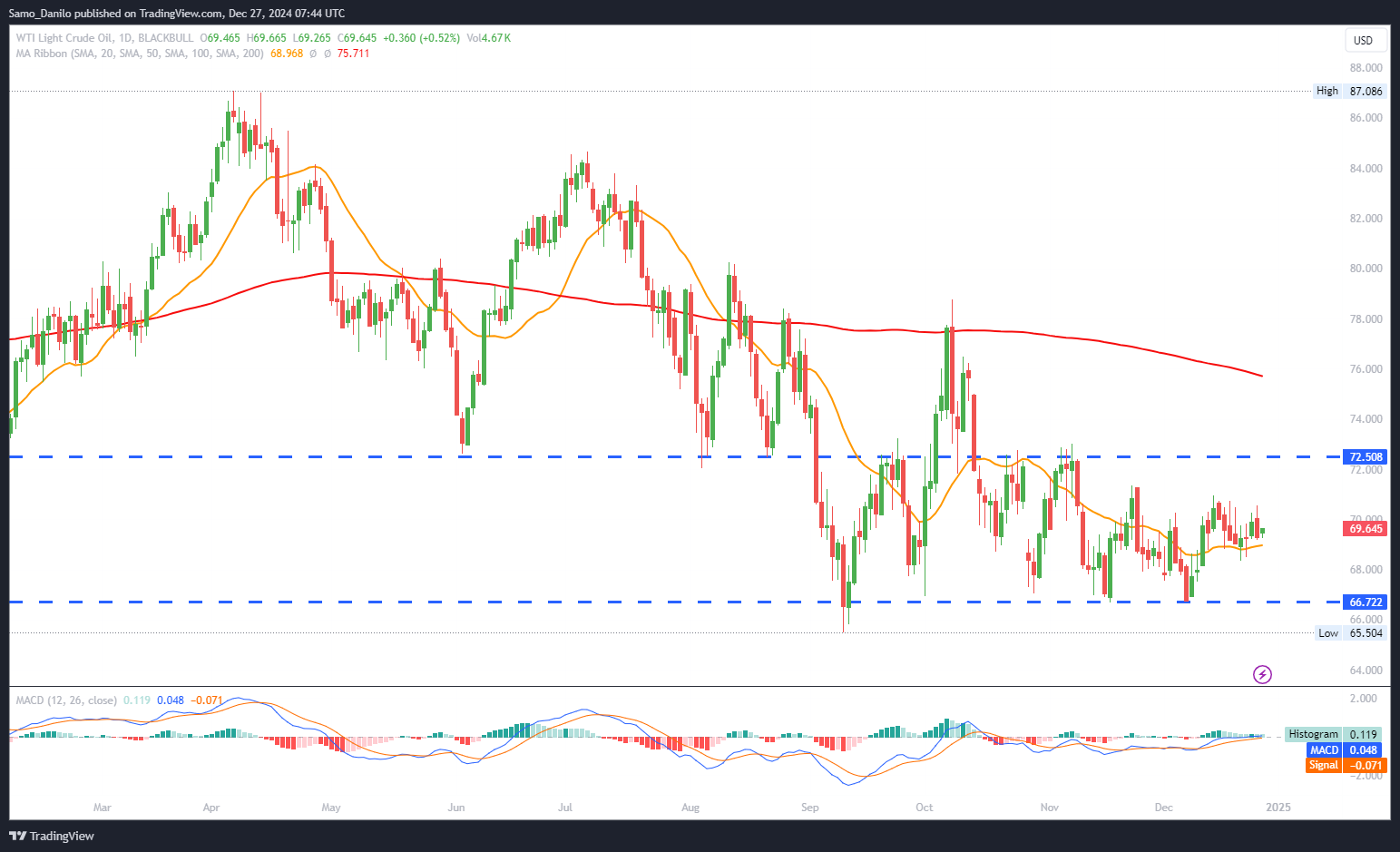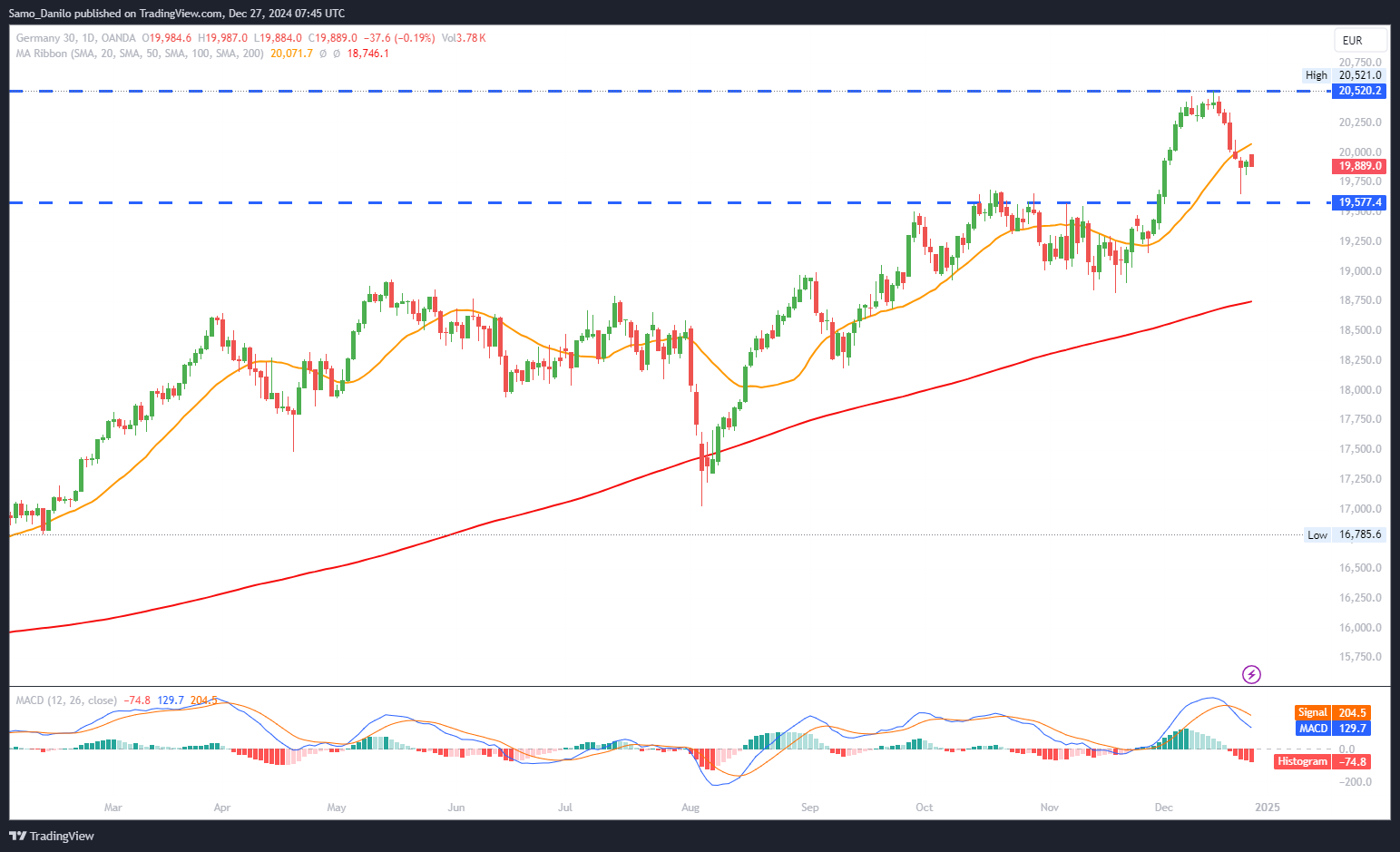EURUSD
- EUR/USD Price: EUR/USD remains confined around 1.0400 during Friday’s European session, with low trading volume and a lack of key catalysts due to the holiday-shortened week. This consolidation reflects uncertainty and indecision among market participants.
- US Labor Market: Weekly Initial Jobless Claims in the US dropped to their lowest in a month, highlighting resilience in the labor market. This supports the US Dollar, limiting EUR/USD’s upward potential.
- ECB’s Rate Cut Projections: ECB Governing Council member Boris Vujcic reiterated the likelihood of further rate cuts if economic conditions align with projections. Market participants expect four consecutive 25 bps cuts in upcoming ECB meetings, adding bearish pressure on the Euro.
- US Trade Data: Later in the day, the US will release the preliminary November Goods Trade Balance. This data could provide fresh direction for the pair, especially if it offers insight into the US trade position heading into 2025.
- Thin Liquidity: With year-end holidays, thin liquidity is expected to dominate, potentially keeping the pair in a narrow range unless significant economic surprises occur.
Closing statement: EUR/USD remains directionless amid subdued trading and diverging central bank policies. US labor market strength and expectations of further ECB rate cuts add to the downside bias, but thin liquidity may delay any decisive moves until early 2025.
GBPUSD
- GBP/USD Price: GBP/USD oscillates within a narrow band above 1.2500 on Friday, following marginal losses on Thursday. This range-bound movement reflects a lack of strong catalysts heading into the year-end holidays.
- Technical Outlook: The daily chart highlights a bearish bias as the pair remains below the 100-day Exponential Moving Average (EMA). This key technical level acts as resistance, suggesting limited upside momentum for now.
- Fed's Hawkish Stance: The Federal Reserve’s decision to lower rates by 25 basis points in December and reduce its 2025 rate-cut projections from four to two strengthens the US Dollar, adding downward pressure to the GBP/USD pair.
- UK Economic Growth: While the UK economy is forecasted to grow in 2025, the Bank of England’s (BoE) 1.5% GDP projection may face downside risks due to uncertainties surrounding trade and a less expansionary budget. These factors could weigh on the Pound in the medium term.
- BoE’s Quarterly Bulletin: Traders now await the BoE's Quarterly Bulletin for additional insights into the UK’s economic outlook and potential policy shifts. This report may influence short-term sentiment for the GBP/USD pair.
Closing statement: GBP/USD remains under technical and fundamental pressure, with bearish signals dominating the outlook. A stronger US Dollar and economic challenges in the UK could keep the pair subdued in the near term, with the BoE’s bulletin potentially providing the next directional cue.
XAUUSD
- Gold Price: Gold prices enter a consolidation phase near $2,630 on Friday after posting gains on Thursday. The precious metal remains in a steady range, reflecting investor caution amid ongoing geopolitical and economic uncertainties.
- Annual Performance: Gold is set to close 2024 with a remarkable 27% annual gain, its best performance since 2010. This rally has been driven by robust central bank purchases, escalating geopolitical tensions, and monetary easing by major central banks, solidifying its status as a preferred safe-haven asset.
- Russia-Ukraine Developments: Russia's Federal Security Service announced that it had stopped multiple assassination plots by Ukrainian intelligence targeting high-ranking Russian officers and their families in Moscow.
- Gaza Developments: Gaza authorities reported that an Israeli airstrike killed five Palestinian journalists. However, the Israeli military claimed that the individuals were members of Islamic Jihad posing as media workers.
- Fed Signals: The Federal Reserve's recent indication of a more restrained approach to rate cuts in 2025 underscores lingering uncertainties about future monetary policy. This dovish shift has supported Gold prices by keeping US Treasury yields in check.
Closing statement: Gold remains well-supported above $2,630, driven by geopolitical tensions and a cautious Federal Reserve outlook. While consolidation may persist in the near term, the precious metal’s strong annual performance suggests it will retain its appeal as a safe-haven investment into 2025.
CRUDE OIL
- WTI Prices: West Texas Intermediate (WTI) crude prices recover to $69.60 per barrel during Friday's European session, following losses in the previous session. The rebound reflects a balancing act between bearish factors and positive sentiment stemming from structural shifts in the energy market.
- European Energy Focus: Reports of major European energy companies prioritizing oil and gas for short-term profits over renewables provide a tailwind for crude prices. This trend, expected to persist through 2025, highlights the sector's pivot to meet immediate energy demands.
- China’s Economic Prospects: The World Bank’s upward revision of China’s growth forecast for 2024 and 2025 offers some optimism for global oil demand. However, lingering issues in the property sector and weak consumer confidence temper the bullish outlook, particularly for the world’s largest oil importer.
- Black Sea Oil Spill: Russia declared a federal emergency following a severe Black Sea oil spill caused by storm-damaged tankers. The incident disrupts local supply chains and could indirectly affect global crude flows, adding volatility to the market.
- India's Challenges: India's state refiners are struggling to secure sufficient Russian crude volumes, signaling potential supply constraints. This development could shift global trade dynamics as India seeks alternative sources, further influencing oil prices.
Closing statement: WTI crude remains supported at $69.60 amid a mix of positive developments and geopolitical risks. While short-term market dynamics, including energy policy shifts and China's recovery, provide a cautiously optimistic outlook, supply-side uncertainties may lead to price fluctuations heading into 2025.
DAX
- DAX Price: The DAX dropped by 0.18% on Monday, closing at 19,849 after Friday's 0.43% decline. Briefly touching the 19,900 level before retreating, the extended losing streak underscores investor concerns over US tariff threats and the Fed's hawkish monetary stance.
- Auto Sector: Germany's auto sector led Monday’s losses, with Volkswagen sliding 1.98% and Porsche dropping 1.62%. Mercedes-Benz Group and BMW also suffered notable declines. The threat of US tariffs on German auto exports has rattled investor sentiment, weighing heavily on these key DAX constituents.
- ECB's Outlook: ECB President Christine Lagarde raised market hopes for a Q1 2025 rate cut, citing progress toward the medium-term inflation target. Lagarde’s remarks supported the prospect of further monetary easing if inflation continues to soften, providing a potential tailwind for equities in the near term.
- US Consumer Confidence: The CB Consumer Confidence Index fell to 104.7 in December, down from 112.8 in November. The weaker consumer sentiment reflects growing uncertainty about the economic outlook, which could dampen global risk appetite, including for DAX-listed stocks.
- US Labor Market: Thursday’s better-than-expected US labor market data, with jobless claims falling slightly to 219k, aligns with the Fed's forecast for fewer rate cuts in 2025. This robust labor market data could challenge demand for risk assets, including European equities.
Closing statement: The DAX’s persistent downtrend reflects heightened geopolitical and monetary policy risks. While ECB rate-cut optimism offers a glimmer of hope, uncertainties surrounding US tariff threats and economic sentiment could limit upside potential in the near term.
